Conversion of non-Islamic places of worship into mosques
.jpg)
The conversion of non-Islamic places of worship into mosques occurred during the life of prophet Muhammad and continued during subsequent Islamic conquests and under historical Muslim rule. As a result, numerous Hindu temples, churches, synagogues, the Parthenon and Zoroastrian temples were converted into mosques. Several such mosques in Muslim or ex-Muslim lands have since reverted or become museums, such as the Hagia Sophia in Turkey and numerous mosques in Spain.
Ka'aba
| Kaaba | |
|---|---|
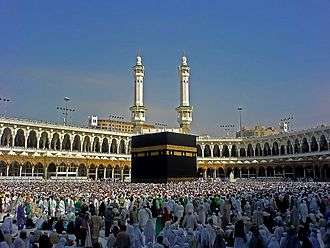 | |
| Basic information | |
| Location | Mecca, Saudi Arabia |
| Affiliation | Islam |
Before the rise of Islam the Ka'aba, and Mecca (previously known as Bakkah), were revered as a sacred sanctuary and was a site of pilgrimage.[1] Some identify it with the Biblical "valley of Baca" from Psalms 84 (Hebrew: בָּכָא).[2][3] At the time of Muhammad (AD 570–632), his tribe the Quraysh was in charge of the Kaaba, which was at that time a shrine containing hundreds of idols representing Arabian tribal gods and other religious figures. Muhammad earned the enmity of his tribe by claiming the shrine for the new religion of Islam that he preached. He wanted the Kaaba to be dedicated to the worship of the one God alone, and all the idols were evicted. The Black Stone (al-Hajar-ul-Aswad), still present at the Kaaba was a special object of veneration at the site. According to tradition the text of seven especially honoured poems were suspended around the Ka'aba. However it is important to note that the Kaba in the first place was built by Prophet Abraham, who was the father of all the Abrahamic religions.
According to Islam, Muhammad's actions were not strictly a conversion but rather a restoration of the mosque established on that site by Abraham, who is considered to be a prophet in Islam. The Ka'aba thus became known as the Masjid al-Haram, or Sacred Mosque, the holiest site in Islam.[4]
Biblical holy sites
Mosques were regularly established on the places of Jewish or Christian sanctuaries associated with Biblical personalities who were also recognized by Islam. The Caliph Umar initially built a small prayer house, which laid the foundation for the later construction of the Al-Aqsa mosque on the Temple Mount, the most sacred site in Judaism, possibly by the Umayyads. The Dome of the Rock was also built on the Temple Mount which was an abandoned and disused area.[5] Upon the capture of Jerusalem, it is commonly reported that Umar refused to pray in the Church of the Holy Sepulchre[6] for fear that later Muslims would then convert it into a mosque in spite of a treaty guaranteeing its safety.[7]
The mosque of Job in Al-Shaykh Saad, Syria, was previously a church of Job.[4] The Herodian shrine of the Cave of the Patriarchs, the second most holy site in Judaism, was converted into a church during the Crusades before being turned into a mosque in 1266 and henceforth banned to Jews and Christians. Part of it was restored as a synagogue after 1967 by Israel.
Hindu, Jain and Buddhist temples
The destruction of Hindu temples in India during the Islamic conquest of India occurred from the beginning of Muslim conquest until the end the Mughal Empire throughout the Indian subcontinent. In his book "Hindu Temples - What Happened to Them", Sita Ram Goel produced a list of 2000 mosques that it is claimed were built on Hindu temples.[8] The second volume of the book excerpts from medieval histories and chronicles and from inscriptions concerning the destruction of Hindu, Jain and Buddhist temples.
In Indonesia, where popular conversion from Hinduism to Islam was slower, it is believed that the minaret of the Menara Kudus Mosque, in Java, was originally part of a Hindu temple.[8]
Menara Kudus Mosque
One of Indonesia's most famous mosques, Menara Kudus has retained much of its former Hindu character. Although the main building has been reconstructed, its iconic minaret and front gates are believed to be relics of a Hindu site.
Ram Janmabhoomi
Ram Janmabhoomi refers to a tract of land in the North Indian city of Ayodhya which is claimed to be the birthplace of Lord Rama. The Archaeological Survey of India (ASI), after conducting excavations at the site, filed a report which stated that a temple stood at the site before the arrival of the Mughals, who constructed the Babri Masjid at the site.[10] Critics of the report state that the "presence of animal bones throughout as well as of the use of 'surkhi' and lime mortar" that was found by ASI are all characteristic of Muslim presence, which they claim "rule out the possibility of a Hindu temple having been there beneath the mosque".[11] From 1528 to 1992 this was the site of the Babri Mosque. The mosque was constructed in 1527 on the orders of Babur, the first Mughal emperor of India, and was named after him. Before the 1940s, the mosque was also called Masjid-i-Janmasthan, translation: ("mosque of the birthplace").The Babri Mosque was one of the largest mosques in Uttar Pradesh, a state in India with some 31 million Muslims. Numerous petitions by Hindus to the courts resulted in Hindu worshippers of Rama gaining access to the site. The mosque was razed on 6 December 1992 by a mob of some 150,000 Hindus supported by the Hindu organisation as per USA records Rashtriya Swayamsevak Sangh (RSS) and the Vishwa Hindu Parishad (VHP),[12][13] after a political rally developed into a riot[14] despite a commitment to the Indian Supreme Court by the rally organisers that the mosque would not be harmed.[15] The Sangh Parivaar, along with VHP and the Bhartiya Janta Party (BJP), sought to erect a temple dedicated to Rama at this site. The 1986 edition of the Encyclopædia Britannica stated that "Rama's birthplace is marked by a mosque, erected by the Moghul emperor Babar in 1528 on the site claimed of an earlier temple".[16] Archaeological excavations at the site by the Archaeological Survey of India reported the existence of a 10th-century temple.[10] The report stated that scientific dating indicated human activity at the site as far back to the 17th century BC.[17]
On 30 September 2010, Allahabad High Court ruled that the 2.7 acres disputed land in Ayodhya, on which the Babri Masjid stood before it was demolished on 6 December 1992, will be divided into three parts: the site of the Ramlala idol to Lord Ram, Nirmohi Akhara gets Sita Rasoi and Ram Chabutara, Sunni Wakf Board gets a third.[18]
Somnath temple
.jpg)
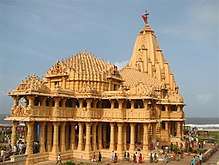
In AD 1025, Mahmud destroyed and looted the Somnath temple, killing over 50,000 people who tried to defend it. The defenders included the 90-year-old clan leader Ghogha Rana. Mahmud personally broke the gilded lingam to pieces and took them back to his homeland and placed them in the steps leading to the newly built Jamiah Masjid, so that they would be stepped upon by those going to the mosque to pray.[19][20] Work on the fourth temple was started immediately by the Paramara King Bhoj of Malwa and the Solanki king Bhima of Patan and the temple was ready by AD 1042. This temple was destroyed in AD 1300. At that time Allaudin Khilji occupied the throne of Delhi and he sent his general, Alaf Khan, to pillage Somnath. The fifth temple was built by King Mahipala of the Chudasama dynasty.[20]
Somnath was repeatedly attacked in the succeeding centuries. The last of these attacks was by the Mughal emperor Aurangazeb in AD 1701. A mosque was built at the site of the temple.[20] In AD 1783 queen Ahilyabhai Holkar built the sixth temple at an adjacent site. The temple still stands and worship is carried out there. After independence, Sardar Vallabhbhai Patel pledged on 13 November 1947, that the seventh temple would be reconstructed. According to prescribed Hindu rituals, pledges are made by taking holy water in one's fist. Leaders like Morarji Desai, Dr. Rajendra Prasad (the first president) and Kanhaiyalal Munshi joined in and the work was entrusted to the Sompura Shilpakars, whose ancestors rebuilt each new temple through the ages. The mosque built by Aurangazeb was not destroyed but carefully relocated. In 1951 Dr. Rajendra Prasad performed the consecration ceremony with the words "The Somnath Temple signifies that the power of creation is always greater than the power of destruction." The temple construction was completed on 1 December 1995, long after the demise of Sardar Patel. The then President of India, Dr. Shankar Dayal Sharma, dedicated it to the nation. Recently, the Shree Somnath Trust has declared that non-Hindus will not be allowed to enter the temple premises. Chairman of Shree Somnath trust is former chief minister of Gujarat Keshubhai Patel and its trustees include Prime Minister of India Narendra Modi, former Chief Secretary of Gujarat P.K. Laheri and former Deputy Prime Minister of India L. K. Advani.[21]
Qutb Minar
Qutb Minar is Built on top of and from the material after destroying 27 Hindu and Jain temples. Qutb ud Din Aibak destroyed nearly a thousand temples and then raised mosques on their foundations including the Jami mosque in Qutub minar complex which he adorned with gold and stones taken from the 27 idol temples that were destroyed using elephants, and covered it with inscriptions from Quran. Aibak ordered the destruction of 27 temples, plinth of one of them was converted into courtyard, original short temple pillars were placed one above another to the desired height, and iron pillar from Gupta empire era was retained, several idols including giant idol of Vishnu reclining on Seshnaga and Lord Brahma on lotus were destroyed, and site simply renamed as Kuwat-ul-islam (light of Islam).
An inscription in Persian at the mosque's inner eastern gateway states that material used in its construction was taken from the demolition of twenty-seven of Delhi's Hindu and Jain temples.[22][23][24] Pillars from these demolished temples were used in the mosque, with their iconography intact. The nearby Iron Pillar from the Gupta empire, which predates the Islamic minar and still bears its Brahmic inscriptions, survived as part of the Qutb complex.[25]
Other references
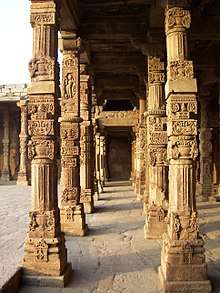
An inscription at the Quwwat Al-Islam Mosque adjacent to Qutb Minar in Delhi states:
"This Jamii Masjid built in the months of the year 587 (hijri) by the Amir, the great, the glorious commander of the Army, Qutb-ud-daula wad-din, the amir-ul-umara Aibeg, the slave of the Sultan, may God strengthen his helpers! The materials of 27 idol temples, on each of which 2,000,000 Deliwal coins had been spent were used in the (construction of) this mosque."[23]
However, as the inscription attests, the mosque was built from the material remnants of Hindu temples that were destroyed by Muslims.
Alberuni in his India[26] writes about the famous temple of Multan:
A famous idol of theirs was that of Multan, dedicated to the sun. When Muhammad Ibn Alkasim Ibn Almunabbih, conquered Multan, he inquired how the town had become so very flourishing and so many treasures had there been accumulated, and then he found out that this idol was the cause, for there came pilgrims from all sides to visit it. Therefore he thought to build a mosque at the same place where the temple once stood. When then the Karmatians occupied Multan, Jalam Ibn Shaiban, the usurper, broke the idol into pieces and killed its priests. When afterwards the blessed Prince Mahmud swept away their rule from those countries, he made again the old mosque the place of the Friday-worship.
An inscription of 1462 A.D.at Jami Masjid at Malan, in Banaskantha District of Gujarat states:
The Jami Masjid was built by Khan-I-Azam Ulugh Khan, who suppressed the wretched infidels. He eradicated the idolatrous houses and mine of infidelity, along with the idols with the edge of the sword, and made ready this edifice. He made its walls and doors out of the idols; the back of every stone became the place for prostration of the believer.[27]
Mughal Emperor Jahangir wrote in his Tujuk-i-Jahangiri:
"I am here led to relate that at the city of Banaras a temple had been erected by Rajah Maun Sing, which cost him the sum of nearly thirty-six laks of five methkaly ashrefies. ...I made it my plea for throwing down the temple which was the scene of this imposture; and on the spot, with the very same materials, I erected the great mosque, because the very name of Islam was proscribed at Banaras, and with God’s blessing it is my design, if I live, to fill it full with true believers."[28]
Zoroastrian temples
After the Islamic conquest of Persia, Zoroastrian fire temples, with their four axial arch openings, were usually turned into mosques simply by setting a mihrab (prayer niche) on the place of the arch nearest to qibla (the direction of Mecca). This practice is described by numerous Muslim sources; however, the archaeological evidence confirming it is still scarce. Zoroastrian temples converted into mosques in such a manner could be found in Bukhara, as well as in and near Istakhr and other Iranian cities,[4] such as: Tarikhaneh Temple, Jameh Mosque of Qazvin, Heidarieh Mosque of Qazvin, Jameh Mosque of Isfahan, Jameh Mosque of Kashan, Jameh Mosque of Ardestan, Jameh Mosque of Yazd, Jameh Mosque of Borujerd, Great Mosque of Herat.
Conversion of church buildings to mosques
Hagia Sophia
Hagia Sophia (from the Greek: Ἁγία Σοφία, "Holy Wisdom"; Latin: Sancta Sophia or Sancta Sapientia; Turkish: Ayasofya) is a former Orthodox patriarchal basilica, later a mosque, and now a museum in Istanbul, Turkey. From the date of its dedication in 360 until 1453, it served as the Greek Patriarchal cathedral of Constantinople, except between 1204 and 1261, when it was converted to a Roman Catholic cathedral under the Latin Patriarch of Constantinople of the Western Crusader established Latin Empire. In 1453, Constantinople was conquered by the Ottoman Turks under Sultan Mehmed II, who subsequently ordered the building converted into a mosque.[29] The bells, altar, iconostasis, and sacrificial vessels were removed and many of the mosaics were plastered over. Islamic features – such as the mihrab, minbar, and four minarets – were added while in the possession of the Ottomans. The building was a mosque from 29 May 1453 until 1931, when it was secularised. It was opened as a museum on 1 February 1935.[30]
Albania
The Catholic church of Saint Nicholas (Shën Nikollë) waw turned into a mosque. After being destroyed in the Communist 1968 anti-religious campaign, the site was turned into an open air mausoleum.
Turkey
Following the Ottoman conquest of Anatolia, virtually all of the churches of Istanbul were desecrated and converted into mosques except the Church of St. Mary of the Mongols. In Anatolia outside of Istanbul, the following churches were desecrated and converted into mosques:
- Orthodox
- Armenian Apostolic
Cyprus
Following the Ottoman conquest of Cyprus, a number of Christian churches were desecrated and then converted into mosques.
- St. Nicholas Cathedral in Famagusta, Cyprus was converted by the Ottoman Turks into Lala Mustafa Pasha Mosque in 1571; remains in use as mosque today.
- St. Sophia Cathedral in Nicosia, Cyprus was converted by the Ottoman Turks into the Selimiye Mosque, Nicosia; remains in use as mosque today.
Greece
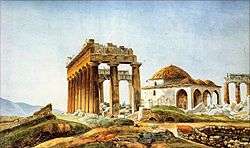
Numerous orthodox churches were converted to mosques during the ottoman period in Greece (turkocracy). Among them:
- Church of the Acheiropoietos and Hosios David (Saint David) in Thessaloniki, both built in 5th century. Also the churches of Prophet Elijah (14th c.), Saint Catherine (14th c.), Saint Panteleimon, Holy Apostles (14th c.), Hagios Demetrios (7th c.), all in Thessaloniki. The Cathedral church of Veria in Greek Macedonia, an 11th c. basilica. These were reconsecrated as christian churches after the liberation of Northern Greece (Macedonia) by the Greek Army in 1912.
- Parthenon in Athens: Some time before the close of the fifteenth century, the Parthenon became a mosque. Before that Parthenon was a Greek Orthodox church.
.jpg)
Hungary
Following the Ottoman conquest of the Kingdom of Hungary, a number of Christian churches were desecrated and then converted into mosques. Those that survived the era of Ottoman rule, were later reconverted into churches after the Great Turkish War.
- Church of Our Lady of Buda, converted into Eski Djami immediately after the capture of Buda in 1541, reconverted in 1686.
- Church of Mary Magdalene, Buda, converted into Fethiye Djami c. 1602, reconverted in 1686.
- The Franciscan Church of St John the Baptist in Buda, converted into Pasha Djami, destroyed in 1686.
Lebanon
- Al-Omari Grand Mosque in Beirut, Lebanon; built as the Church of St. John the Baptist by the Knights Hospitaller; converted to mosque in 1291.
Morocco
- Grand Mosque of Tangier; built as Church
Syria
- Umayyad Mosque in Damascus; built on the site of a Christian basilica dedicated to John the Baptist (Yahya)
- Great Mosque of al-Nuri in Homs; initially a pagan temple for the sun god ("El-Gabal"), then converted into a church dedicated to Saint John the Baptist
- Great Mosque of Hama; a temple to worship the Roman god Jupiter, later it became a church during the Byzantine era
- Great Mosque of Aleppo; the agora of the Hellenistic period, which later became the garden for the Cathedral of Saint Helena
Post-Colonial North Africa
A number of North African cathedrals and churches were confiscated and/or forcibly converted into mosques in the mid-20th century
- St. Philip Cathedral in Algiers, Algeria (originally a mosque, converted to a church in 1845, reconverted to the Ketchaoua Mosque in 1962)
- Cathédrale Notre-Dame des Sept-Douleurs in Constantine, Algeria
- Tripoli Cathedral in Tripoli, Libya (converted to Maidan al Jazair Square Mosque)
Others were desecrated and later destroyed after the Christian congregants were expelled.
Iraq
The Islamic State of Iraq and Syria converted a number of Christian churches into mosques after they occupied Mosul in 2014. The churches were restored into its original functions after Mosul was liberated in 2017.[31]
- Syrian Orthodox Church of St. Ephraim in Mosul, Iraq; converted to the Mosque of the Mujahideen
- Chaldean Church of St. Joseph in Mosul, Iraq
Israel
The practice today
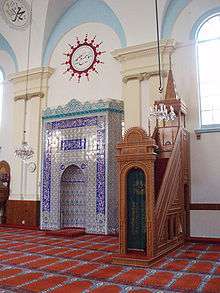
The conversion of non-Islamic places of worship into mosques has abated since no major territorial acquisitions have been made by Muslim-majority populations in recent times. However, some of the Greek Orthodox churches in Turkey that were left behind by expelled Greeks in 1923 were converted into mosques.
A relatively significant surge in church-mosque conversion followed the 1974 Turkish Invasion of Cyprus. Many of the Orthodox churches in Northern Cyprus have been converted, and many are still in the process of becoming mosques.
Churches and synagogues in non-Islamic countries re-arranged as mosques
In areas that have experienced Muslim immigration, such as parts of Europe and North America,[32][33] some church buildings, and those of other religious congregations, that have fallen into disuse have been converted into mosques following a sale of the property.
In London, the Brick Lane Mosque has previously served as a synagogue.
Germany
- Neuapostolische Kirche in Berlin-Tempelhof[34]
- Methodist Church in Mönchengladbach[35]
- Evangelische Notkirche Johannes, Kielstraße, Dortmund, now Merkez Camii (DITIB)
- Kapernaumkirche (Hamburg-Horn)
Further reading
- Narain, Harsh (1993). The Ayodhya Temple Mosque Dispute: Focus on Muslim Sources. Delhi: Penman Publishers.
- Arun Shourie, Sita Ram Goel, Harsh Narain, Jay Dubashi and Ram Swarup. Hindu Temples - What Happened to Them Vol. I, (A Preliminary Survey) (1990) ISBN 81-85990-49-2
See also
| Wikiquote has quotations related to: Conversion of non-Islamic places of worship into mosques |
- Buddhas of Bamiyan
- Islam and other religions
- Christianized sites
- Category:Mosques converted from churches by the Ottoman Empire
References
- ↑ Britannica 2002 Deluxe Edition CD-ROM, "Ka'bah."
- ↑ Daniel C. Peterson (2007). Muhammad, prophet of God. Wm. B. Eerdmans Publishing. pp. 22–25. ISBN 978-0-8028-0754-0.
- ↑ Psalms 84:6, King James Version
- 1 2 3 Hillenbrand, R. "Masdjid. I. In the central Islamic lands". In P.J. Bearman; Th. Bianquis; C.E. Bosworth; E. van Donzel; W.P. Heinrichs. Encyclopaedia of Islam Online. Brill Academic Publishers. ISSN 1573-3912.
- ↑ "Routledge Encyclopedia of Ancient Mediterranean Religions". Books.google.com. Retrieved 7 May 2016.
- ↑ He was touring the Church and prayer time came around and he requested to be shown to a place where he may pray and the Patriarch said "Here".
- ↑ Adrian Fortescue, "The Orthodox Eastern Church", Gorgias Press LLC, 1 Dec 2001, pg. 28 ISBN 0-9715986-1-4
- 1 2 "Hindu Temples-What Happened to Them by Sita Ram Goel". Scribd.com. 1990-04-07. Retrieved 2016-05-07.
- ↑ Schoppert, P., Damais, S., Java Style, 1997, Didier Millet, Paris, p. 207, ISBN 962-593-232-1
- 1 2 Proof of temple found at Ayodhya: ASI report Rediff News, 25 August 2003 19:35 IST
- ↑ Ayodhya verdict yet another blow to secularism: Sahmat The Hindu, 3 October 2010
- ↑ "Archived copy". Archived from the original on 17 January 2008. Retrieved 26 September 2010.
- ↑ Uproar over India mosque report: Inquiry into Babri mosque's demolition in 1992 Al-Jazeera English – 24 November 2009
- ↑ Babri mosque demolition case hearing today. Yahoo News – 18 September 2007
- ↑ Tearing down the Babri Masjid – Eye Witness BBC's Mark Tully BBC – Thursday, 5 December 2002, 19:05 GMT
- ↑ 15th edition of the Encyclopædia Britannica, 1986, entry "Ayodhya", Chicago: Encyclopædia Britannica Inc.
- ↑ "The ASI Report - a review". Hindu.com. 6 December 1992. Archived from the original on 10 November 2012. Retrieved 7 May 2016.
- ↑ "Disputed Ayodhya site to be divided into 3 parts- TIMESNOW.tv – Latest Breaking News, Big News Stories, News Videos". Timesnow.Tv. Retrieved 6 March 2012.
- ↑ "Mosque and Tomb of the Emperor Soolta Mahmood of Ghuznee". Bl.uk. 2003-11-30. Retrieved 2016-05-07.
- 1 2 3 "Temples of India". Books.google.com. p. 8. Retrieved 2016-05-07.
- ↑ "No entry for non-Hindus' to Somnath temple without permit in Gujarat - Times of India". Timesofindia.indiatimes.com. 2015-06-03. Retrieved 2016-05-07.
- ↑ Ali Javid; ʻAlī Jāvīd; Tabassum Javed. "World Heritage Monuments and Related Edifices in India". Page.14,263. Google Books. Retrieved 26 May 2009.
- 1 2 Epigraphia Indo Moslemica, 1911–12, p. 13.
- ↑ "Index 1200-1299: Qutb ud-Din Aibak and the Qubbat ul-Islam mosque.", Columbia University
- ↑ Singh (2010). Longman History & Civics ICSE 7. Pearson Education India. p. 42. ISBN 978-81-317-2887-1. Retrieved 27 October 2011.
- ↑ Alberuni's India, Edward C. Sachau (translator and editor)
- ↑ Epigraphia Indica-Arabic and Persian Supplement, 1963, Pp. 26–29
- ↑ "Decisions Involving Urban Planning and Religious Institutions". Persian.packhum.org. Retrieved 2016-05-07.
- ↑ "Archived copy". Archived from the original on 5 January 2009. Retrieved 13 February 2009.
- ↑ Magdalino, Paul; et al. ""Istanbul: Buildings, Hagia Sophia" in Grove Art Online". Oxfordartonline.com. Retrieved 28 February 2010.
- ↑ "Iraq: Daesh have robbed and demolished every church". Independent Catholic News. 6 March 2018. Retrieved 20 March 2018.
- ↑ Perlez, Jane (2 April 2007). "Old Church Becomes Mosque in Uneasy Britain". The New York Times. Retrieved 30 April 2010.
- ↑ Applebome, Peter (18 August 2010). "Utica Welcomes a New Mosque Replacing an Old Church". The New York Times. Retrieved 29 April 2011.
- ↑ Gotteshäuser: Aus Kirchen werden Moscheen, Tagesspiegel, 5. Oktober 2007.
- ↑ Marion Menne: "Wirbel um Kirchen-Verkauf". Archived from the original on 16 May 2013. Retrieved 28 October 2016. , WDR, 25. Juni 2012.
